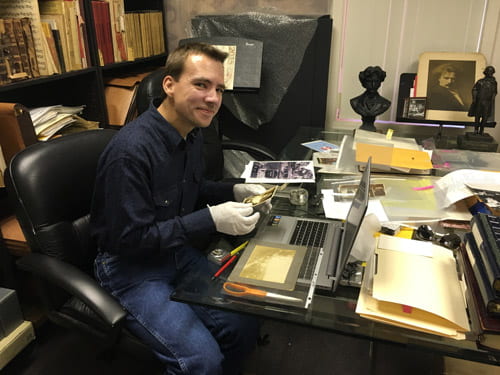From October 1 – November 15, 2015, the Polish Music Center hosted Robert Górski, a scholar and archivist with the Central Directorate of the Polish National Archives (NDAP) in Warsaw. This residency was the latest installment in a partnership and professional exchange that has been developing between the National Archives and the PMC over the last five years. Since 2013, two scholars have spent extended periods at the Polish Music Center, teaching PMC staff and cataloguing our extensive archives, and PMC staff have visited various branches of the National Archives in Poland, learning archival and restoration techniques and sharing our skills for the development of English language terminology and databases. This ongoing partnership is co-funded by the NDAP, the PMC, and the Ministry of Foreign Affairs of the Republic of Poland.
Mr. Górski is not only a skilled and diligent archivist, he is also perhaps the world’s leading expert on the current contents and location of all of the various parts of the archives of Ignacy Jan Paderewski, which have been scattered around the world since Paderewski’s death. Given this expertise, Mr. Górski delved into the PMC’s extensive Paderewski Collection immediately upon his arrival and continued to explore its many facets for the following 6 weeks in Los Angeles. Many exciting discoveries were made as he worked to fit the PMC’s collection into the larger context of all extant Paderewski archives around the world. Below is an excerpt from his report on his time at the PMC:
The Paderewski Collection in the PMC […] is one of the largest parts of Paderewski’s personal archive that is dispersed among several institutions (archives, libraries), ex. in the Central Archive of Modern Records in Warsaw that has thousands of documents created by Paderewski, his family and his close friends (ex. Strakacz family); the Institute of Musicology at the Jagiellonian University in Kraków, Poland; The Hoover Institution on War, Revolution, and Peace Archives, Stanford, CA; or Polish Museum in Chicago, IL. The PMC acquired a part of this whole archive from two sources—from Harry E. Blythe and Annette Strakacz-Appleton. Among these papers we can find photographs depicting Paderewski and his family and friends in his California estates, in Palm Springs, FL, or Oak Ridge, NY, as well as his portrait pictures, posters, correspondence, concert programs, paper clippings, many items that have belong to Paderewski and his wife: a few decks of cards, a Kodak camera, a watch that Paderewski received from his father, a ring from Queen Victoria, bookmarks, fabrics and more. There are also many books and recordings on VHS, related to Paderewski and history of Poland. Many of the documents were glued or put into albums [by the previous collector], but without any particular order. The most important task during my one and half month was to separate materials that are not part of Paderewski archive according to the principle of provenance. These were mostly books and recordings and they will become a part of separate collections or the library at the PMC.
Then I began to arrange and describe the photographs, giving them new numbers and a new order within groups, using a FOTOGRAP database designed by Polish State Archives. That was not easy work because of the lack of information on depicted persons, places, events and the dates of events. In many cases, descriptions provided by the donors weren’t precise. There were also many copies of the same photographs in different sizes. There are also many photographs that were taken in Paderewski’s villa in Riond Bosson, Switzerland. They need to be arranged and described, but before that there is a need to make a digital copy of each page of the albums just to preserve the original order and then to consult with conservation professionals, because these pictures were unfortunately glued into the albums. Then—if everything will go well—we will continue our collaboration in LA and of course across the Ocean (with a great pleasure!).
Indeed, there is still much work to do, within the Paderewski Collection as well as within the many other rare and valuable parts of the PMC’s archives. We look forward to continuing our collaboration with the National Archives in 2016 and beyond.
